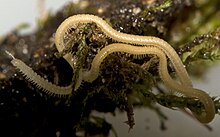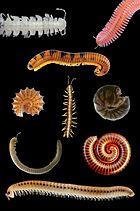| Siphonophorida Temporal range: Cenomanian–Present PreꞒ Ꞓ O S D C P T J K Pg N | |
|---|---|

| |
| Illacme plenipes | |
| Scientific classification | |
| Domain: | Eukaryota |
| Kingdom: | Animalia |
| Phylum: | Arthropoda |
| Subphylum: | Myriapoda |
| Class: | Diplopoda |
| Subclass: | Chilognatha |
| Infraclass: | Helminthomorpha |
| Clade: | Colobognatha |
| Order: | Siphonophorida Newport, 1844 |
| Families | |
| Synonyms | |
|
Californizoniinae Verhoeff, 1941 | |
Siphonophorida (Greek for "tube bearer") is an order of millipedes containing two families and over 100 species.
Description
Millipedes in the order Siphonophorida are long and worm-like, reaching up to 36 millimetres (1.4 in) in length and up to 190 body segments. Eyes are absent, and in many species the head is elongated into a long beak, with mandibles highly reduced. The beak may serve in a suctorial function. The body has a dense covering of fine setae. Each body segment consists of a dorsal tergite, two lateral pleurites, and ventral sternite, which are unfused. The male reproductive appendages (gonopods) are simple and leg-like, consisting of the ninth and 10th leg pairs. This lack of specialization has led to Siphonophorida being called a "taxonomist's nightmare", and Jeekel (cited in) jokingly gave the order the "taxonomists' award for least popular group among diplopods".
Distribution
Siphonophorida occurs from southwestern USA to Brazil and Peru in the western hemisphere, as well as South Africa, India, southeast Asia and Australia. The oldest fossil of the group is from the Late Cretaceous (Cenomanian) aged Burmese amber, assignable to the extant genus Siphonophora.
Classification
Two families are traditionally recognized. Differences between the two families include antennae and head structure: the large family Siphonophoridae, with over 100 species, has elongate beak-like mouthparts, and straight antennae with sensory pits on the fifth and sixth antennal segments ("antennomeres)". The family Siphonorhinidae, with only around 10 species, lacks the beak-like mouthparts, and has geniculate (elbowed) antennae lacking sensory pits on the fifth and sixth antennomere. The siphonorhinid genus Nematozonium with two species, is sometimes placed in its own monotypic family, Nematozoniidae.
Family Siphonophoridae Newport, 1844


- Balizonium
- Columbianum
- Gonatotrichus
- Linozonium
- Lomboknium
- Okeanozonium
- Pterozonium
- Tugrazontium
- Rhinosiphora
- Siphonacme
- Siphonophora
Family Siphonorhinidae Cook, 1895
References
- ^ Read, H. J.; Enghoff, H. (2009). "The order Siphonophorida– A taxonomist's nightmare? Lessons from a Brazilian collection" (PDF). Soil Organisms. 81: 543–556.
- "Diagnostic features of Millipede Orders" (PDF). Milli-PEET Identification Tables. The Field Museum, Chicago. Retrieved 25 October 2013.
- "Geographic distribution of Millipede Families" (PDF). Milli-PEET Identification Tables. The Field Museum, Chicago. Retrieved 25 October 2013.
- Jiang, Xuankong; Shear, William A.; Hennen, Derek A.; Chen, Huiming; Xie, Zhicai (May 2019). "One hundred million years of stasis: Siphonophora hui sp. nov., the first Mesozoic sucking millipede (Diplopoda: Siphonophorida) from mid-Cretaceous Burmese amber". Cretaceous Research. 97: 34–39. doi:10.1016/j.cretres.2019.01.011. S2CID 134500770.
External links
 Media related to Siphonophorida at Wikimedia Commons
Media related to Siphonophorida at Wikimedia Commons Data related to Siphonophorida at Wikispecies
Data related to Siphonophorida at Wikispecies
| Orders of the class Diplopoda (millipedes) | |||||||||||||||||||||||||||||||||
|---|---|---|---|---|---|---|---|---|---|---|---|---|---|---|---|---|---|---|---|---|---|---|---|---|---|---|---|---|---|---|---|---|---|
| |||||||||||||||||||||||||||||||||
| |||||||||||||||||||||||||||||||||
| |||||||||||||||||||||||||||||||||
| Taxon identifiers | |
|---|---|
| Siphonophorida | |

